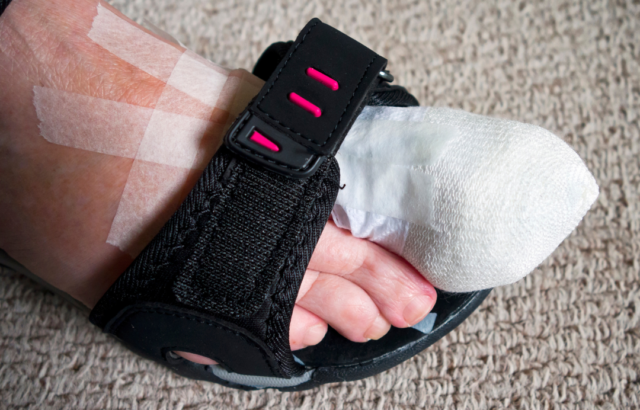
For those undergoing ingrown toenail surgery, it can feel like a massive weight has been lifted off of your shoulders (or toes), finally giving you much-needed relief from the pain and discomfort. And as with any minor surgical procedure, having proper care after your procedure is essential for a smooth and speedy recovery. To ensure you heal quickly and safely, we have compiled eight tips to guide you through the recovery process.
Note: you should also receive post-surgical recovery instructions from your specific clinic and podiatrist, so always ensure that you always follow those and ask your podiatrist if you have any questions.
1. Keep the surgical area clean
Following your podiatrist’s instructions for wound care, keep the surgical area (the toe that had the partial nail avulsion procedure) clean and dry to help minimise your risk of infection. Use mild, fragrance-free soap when cleaning the area and pat it dry gently.
2. Wear comfortable footwear with a spacious toe box
Opt for shoes that provide ample room for your toes and avoid putting pressure on the surgical area. This may be ones with a spacious toe box, to make room for your thick winter socks. Ultimately, you want to choose breathable and supportive shoes to aid in the healing process. If necessary, we can recommend specific footwear or shoe modifications.
3. Elevate your feet when resting
Elevating your feet when resting (or at least the foot that has had the procedure) can help reduce your swelling and help improve circulation. Prop up your foot on a pillow or cushion whenever you’re sitting or lying down. Aim to keep your foot elevated above heart level for optimal results.
4. Use NSAIDs as needed
If you’re experiencing pain or discomfort after your procedure, you don’t need to put up with it. You can use non-steroidal anti-inflammatory medications (NSAIDs) as needed to help you manage your pain, assuming that you have no contraindications to the medicine.
5. Avoid excessive pressure or trauma
During the recovery period, avoid any activities that may put excessive pressure or trauma on the toe(s). This includes high-impact exercises, running, and activities that require prolonged standing or walking.
6. Maintain proper foot hygiene
Practise good foot hygiene to prevent infection. Keep your feet clean and dry, follow your podiatrists’ dressing change instructions, change your socks daily, and avoid wearing tight or restrictive footwear that may increase moisture and bacteria buildup.
7. Avoid self-treatment
While it may be tempting to follow the advice of well-meaning family members or friends who may be trying to help or support you after your procedure, it’s important to carefully follow your post-op instructions, and leave any other additional ‘home remedies’ aside. Leaving your care to the expertise of your podiatrist to prevent complications and promote proper healing will help you get the best results.
8. Any questions? Just ask.
Don’t be afraid to get in touch with your podiatrist as often as you need to if you have any questions in the days and weeks following your procedure. You should also have some follow-up appointments scheduled to check on your progress and help with any wound redressing.
We’re Auckland’s Ingrown Toenail Experts
Our experienced podiatry team is here to help, and leave you feeling great on your feet. Book your appointment online here or call us on 09 523 2333
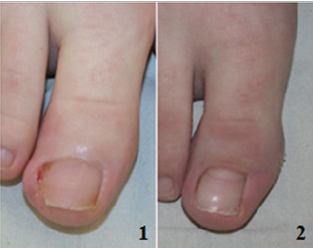
Partial nail avulsions are our most popular and effective solution to ingrown toenails – permanently. If you’re thinking about having this procedure and have heard that it involves removing a small part of the problematic edge of your toenail, you may wonder what your nail may end up looking like after it has healed.
The simple answer is that, in our clinic at least, your nail won’t look very different from its pre-surgery state. Our experienced podiatrists are careful to only remove the smallest area of nail we need to, to get the ingrown portion of the nail out confidently, while allowing us to get down to the nail-growing cells at the base of your toenail to prevent them regrowing in the future – so the problem nail edge no longer continues to give you trouble.
The result is a very straight nail edge that doesn’t curve downwards into the toe. Our patients often describe this as being unnoticeable until they point it out to someone, with which the response is “oh yeah I see what you mean”.
With this said, overall the results do vary from person to person, as everyone has natural differences in the shape of their toenail, the size and features of their toes, differences in the amount of skin surrounding their toenails, and more. More than this, some people only have minor ingrown toenails when they have the procedure, while others have severely swollen ingrown toenails, on both sides of the toenail, that have been bleeding for weeks and they’ve had to take antibiotics for the infection. All these features, particularly where there has been new excess tissue growth, can also affect the outcome and appearance of the toe once it has healed. This is something that we’re always happy to discuss with you at your first appointment when we can have a look at your toe, and help you answer any more questions you may have.
To help you get a better idea of what you can expect, here are some examples of nails after their procedure, both from our clinic and from others.
Before & three months after images of one side of the toenail being treated
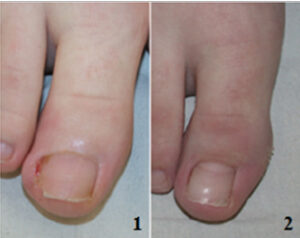 Two sides of the toenail having the procedure:
Two sides of the toenail having the procedure:
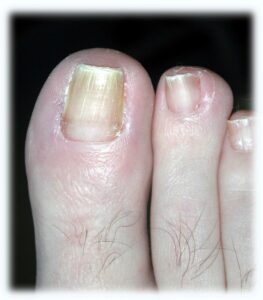 Before, two weeks after, and six months after the procedure
Before, two weeks after, and six months after the procedure
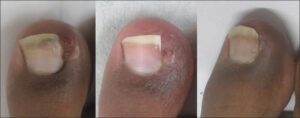 Before, two weeks after, and six months after the procedure
Before, two weeks after, and six months after the procedure
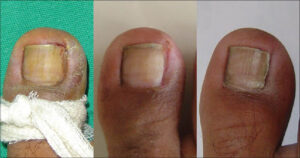 One side of the toenail, after surgery
One side of the toenail, after surgery
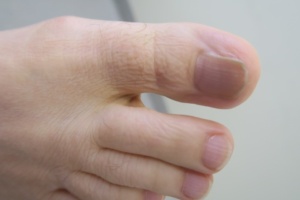 Surgery on the left side of the toenail only
Surgery on the left side of the toenail only
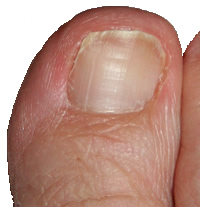
Want to know more about ingrown toenails or the nail correction procedure?
You’ve come to the right place! We’ve shared all about ingrown toenails and why they develop here. To learn more about our three treatment options for ingrown toenails, clinic on the links below:
For our commonly asked questions around ingrown toenails, please visit our FAQ page or our blog.
Ready to finally get rid of your ingrown toenail with Auckland’s experts?
Ingrown toenails are our speciality, and we’re the only clinic in Auckland to have a section of our practice completely dedicated to permanently resolving ingrown toenails. Book your appointment online here or call us on 09 523 2333

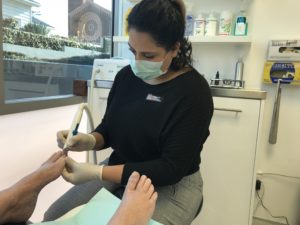 Ever wish you knew someone that has gone through the same procedure as you so you knew what to expect? We absolutely get it – and while ingrown toenail surgeries are common enough these days that you’ll likely know someone that has had it done – it’s also not the type of thing that many go bragging to their friends about. So, we’ve shared the experience for you!
Here’s the low-down on what having an ingrown toenail surgery with the Auckland Ingrown Toenail Clinic is really like, as told retrospectively by one of our patients.
Choosing the Auckland Ingrown Toenail Clinic
I found the ingrown toenail clinic, and hence Perform Podiatry, on Google. They weren’t too far away, they had good reviews, and I liked that the podiatrist I’d be seeing would be very experienced in ingrown toenails. The website also mentioned an all-inclusive price – I know multiple appointments with health professionals can add up quickly, so knowing the full cost was great.
The First Appointment
I decided to see someone about my ingrown toenail because this was my third ingrown in the last 4 or so years. I was over the pain and wanted it fixed by a professional. I called in the afternoon and got an appointment for the next day.
The first part of the appointment was easy. The podiatrist checked my nail and asked a bunch of questions. She told me that I had multiple options, and what each involved. One option was to remove the piece of nail that was causing me pain right there and then. I was told that was good for those who have never had an ingrown nail before, as it may not come back. I knew I needed something permanent so I wouldn’t have to deal with this nail in the future.
One of the other options was a procedure called a partial nail avulsion. It’d be done in under an hour, it was permanent (or they’d re-do it), I’d need minimal time off work, and I met their criteria for the procedure. This was what I’d wanted.
The Procedure
I booked in to have the procedure the next day as it’d be a Friday and I’d have the weekend to take it easy.
When I arrived, the room was already “set up” – very clean and with the equipment ready. The same podiatrist that I saw the day before cleaned my toe with iodine and the worst part of the procedure was done – the anaesthetic. It worked, my toe was numb, and the only thing I felt for the rest of the time was pressure.
They showed me the piece of nail they removed – it was bigger than I thought. It looked like I had cut the nail but missed the part right at the end and just pulled the nail off, leaving a big piece in.
They put a bunch of bandages on my toe to protect it. The whole process was done in about 45-50 minutes. I was given instructions to come back on Monday, NOT get the toe wet in any way, not wear tight shoes, rest the foot and put it on a pillow on the couch, and that if it becomes painful to take some specific painkillers. I did take some Friday night as my toe throbbed after the anaesthetic wore off but didn’t take any more after that. I didn’t do too much on the weekend, and avoided putting on closed shoes as that’d hurt the toe.
The Check
At Monday’s appointment, I got a bag filled with the same dressings they used. They removed my dressings to check how the toe was going (which seemed fine) and taught me how to dress it again. I was told to re-dress it anytime it got wet and every few days for the next week. I was to come back in another week to check that it was healing nicely. I went back to work that week and wore shoes that didn’t press on my toe. I redressed as instructed.
A week later I came back and was told that as everything had closed over nicely, I could change the dressings as the infection risk was minimised. The toe was still a bit pink and I could see the dried blood etc, but it wasn’t painful as long as I didn’t hit it/push against it and I was told it was healing nicely, and to let the podiatrist know if anything changed.
The Result
About 7 or so weeks later the toe was pretty much back to normal. The nail was a little smaller, but not by much and you can’t really tell unless I point it out. The nail edge is just very smooth and straight and doesn’t curl down into the side so much. Am now looking forward to not having any problems with my toenail!
Ever wish you knew someone that has gone through the same procedure as you so you knew what to expect? We absolutely get it – and while ingrown toenail surgeries are common enough these days that you’ll likely know someone that has had it done – it’s also not the type of thing that many go bragging to their friends about. So, we’ve shared the experience for you!
Here’s the low-down on what having an ingrown toenail surgery with the Auckland Ingrown Toenail Clinic is really like, as told retrospectively by one of our patients.
Choosing the Auckland Ingrown Toenail Clinic
I found the ingrown toenail clinic, and hence Perform Podiatry, on Google. They weren’t too far away, they had good reviews, and I liked that the podiatrist I’d be seeing would be very experienced in ingrown toenails. The website also mentioned an all-inclusive price – I know multiple appointments with health professionals can add up quickly, so knowing the full cost was great.
The First Appointment
I decided to see someone about my ingrown toenail because this was my third ingrown in the last 4 or so years. I was over the pain and wanted it fixed by a professional. I called in the afternoon and got an appointment for the next day.
The first part of the appointment was easy. The podiatrist checked my nail and asked a bunch of questions. She told me that I had multiple options, and what each involved. One option was to remove the piece of nail that was causing me pain right there and then. I was told that was good for those who have never had an ingrown nail before, as it may not come back. I knew I needed something permanent so I wouldn’t have to deal with this nail in the future.
One of the other options was a procedure called a partial nail avulsion. It’d be done in under an hour, it was permanent (or they’d re-do it), I’d need minimal time off work, and I met their criteria for the procedure. This was what I’d wanted.
The Procedure
I booked in to have the procedure the next day as it’d be a Friday and I’d have the weekend to take it easy.
When I arrived, the room was already “set up” – very clean and with the equipment ready. The same podiatrist that I saw the day before cleaned my toe with iodine and the worst part of the procedure was done – the anaesthetic. It worked, my toe was numb, and the only thing I felt for the rest of the time was pressure.
They showed me the piece of nail they removed – it was bigger than I thought. It looked like I had cut the nail but missed the part right at the end and just pulled the nail off, leaving a big piece in.
They put a bunch of bandages on my toe to protect it. The whole process was done in about 45-50 minutes. I was given instructions to come back on Monday, NOT get the toe wet in any way, not wear tight shoes, rest the foot and put it on a pillow on the couch, and that if it becomes painful to take some specific painkillers. I did take some Friday night as my toe throbbed after the anaesthetic wore off but didn’t take any more after that. I didn’t do too much on the weekend, and avoided putting on closed shoes as that’d hurt the toe.
The Check
At Monday’s appointment, I got a bag filled with the same dressings they used. They removed my dressings to check how the toe was going (which seemed fine) and taught me how to dress it again. I was told to re-dress it anytime it got wet and every few days for the next week. I was to come back in another week to check that it was healing nicely. I went back to work that week and wore shoes that didn’t press on my toe. I redressed as instructed.
A week later I came back and was told that as everything had closed over nicely, I could change the dressings as the infection risk was minimised. The toe was still a bit pink and I could see the dried blood etc, but it wasn’t painful as long as I didn’t hit it/push against it and I was told it was healing nicely, and to let the podiatrist know if anything changed.
The Result
About 7 or so weeks later the toe was pretty much back to normal. The nail was a little smaller, but not by much and you can’t really tell unless I point it out. The nail edge is just very smooth and straight and doesn’t curl down into the side so much. Am now looking forward to not having any problems with my toenail!



 Two sides of the toenail having the procedure:
Two sides of the toenail having the procedure:

 Before, two weeks after, and six months after the procedure
Before, two weeks after, and six months after the procedure
 One side of the toenail, after surgery
One side of the toenail, after surgery
 Surgery on the left side of the toenail only
Surgery on the left side of the toenail only


 Ever wish you knew someone that has gone through the same procedure as you so you knew what to expect? We absolutely get it – and while ingrown toenail surgeries are common enough these days that you’ll likely know someone that has had it done – it’s also not the type of thing that many go bragging to their friends about. So, we’ve shared the experience for you!
Ever wish you knew someone that has gone through the same procedure as you so you knew what to expect? We absolutely get it – and while ingrown toenail surgeries are common enough these days that you’ll likely know someone that has had it done – it’s also not the type of thing that many go bragging to their friends about. So, we’ve shared the experience for you!